
(A work in progress)
While
there are many symbols sacred to many cultures and toutas in our
Sinnsreachd and
of possible amulet or use in Draíocht .
I will be trying to keep adding to this blog so that it becomes
a chapter in Lebor
Druidic.
Ref.http://hoodoo-vodou-druido-grove.blogspot.com/2014/03/old-irish-terms-i-have-used.html
Ref.http://hoodoo-vodou-druido-grove.blogspot.com/2014/03/old-irish-terms-i-have-used.html
I
will use some from dear departed Isaac Bonewits web site to start
off.
And
then as time allows add historic links to their use if I can find
them.
A::
Acorn:
A::
Acorn:
Adder:
Anguinum;
glain y nidir; mân macal
The
Druid's Egg (also “glain,” “serpent's egg,” or “snake
stone”)
anguinum
> Ref. > Pliny's Natural History, XXIX.52.:
Awen:

by Edward Williams (Iolo Morganwg) 1747-1826 From the Lebors "Barddas 1862 and 1874"

Edward Williams (Iolo Morganwg) 1747-1826
Much could be said here but that is not our purpose now.
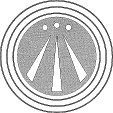
The Order of Bards Ovates and Druids places the Awen inside a set of three circles (right), representing Iolo’s three “stages of existence.” Again influence from the "Barddas Lebors"
B::Bell Branch
Lets not forget the Bard's Bell Branch or that of the Moot's too.
(Add Pictures here)
C::
Cauldrons:"The Cauldron of Poesy" Here we have both internal Cauldrons and again the number three.
http://www.ancientmusic.co.uk/files/cauldron_of_poesy.pdf
Celtic knots: are a variety of knots and stylizedgraphical representations of knots used for decoration, used extensively in the Celtic style of Insular art. These knots are most known for their adaptation for use in the ornamentation of Christian monuments and manuscripts, such as the 8th-century St. Teilo Gospels, the Book of Kells and the Lindisfarne Gospels. Most are endless knots, and many are varieties of basket weave knots.
Almost
all of the folios of the Book of Kells contain small illuminations
like this decorated initial.
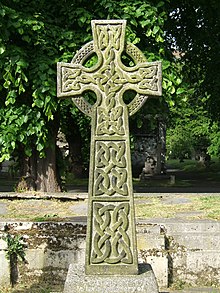
D::
The
Druid Sigils

Often
used by the "RDNA Reformed Druids North America"
ADF
"Ár nDraíocht Féin: A Druid Fellowship" Sigal
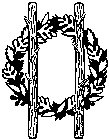
Merlins-Sigil
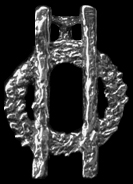

Keltria, a Neopagan Druid organization that branched off from ADF, has kept the Druid Sigil as a wreath and added the Awen in the cente.
E::
Egg:
Anguinum; glain y nidir; mân macal
Egg:
Anguinum; glain y nidir; mân macal
The
Druid's Egg (also “glain,” “serpent's egg,” or “snake
stone”)
anguinum
> Ref. > Pliny's Natural History, XXIX.52.:
F::
Foot:
The Druids Foot or Drudden Fuss

A serpentine stone with a hole in it is also called a Druid's Foot.

Also
in Hanover: A church with a pentagram
Some also call a Pentacle a Druid's Foot.
Ref.
see:
Penta
Pentacle
Pentagram
http://hoodoo-vodou-druidogrove.blogspot.com/2014/05/penta-pentacle-pentagram.html
Ref. Drudden Fuss:
http://hoodoo-vodou-druidogrove.blogspot.com/2014/05/penta-pentacle-pentagram.html
Ref. Drudden Fuss:
A dissertation upon the Druids
by M. Esaias Pufendorff, of Chemnitz. Translated from the Latin by Edmund Goldsmid
Publication
Date: 1650; this translation published in 1886.
H::
Hazel Nuts and Trees:Celtic Irish myth of the Well of Segais (Well of Wisdom), a well or pool surrounded by nine hazel trees. These hazel trees dropped their nuts into the water and the water sustained the trees. In turn the Salmon of Knowledge ate the nuts that fell into the water,and to eat the salmon meant that the person was granted knowledge and poetic inspiration.
O::
Oak Trees:
P::
Pine-tree : symbolic of responsibility, valour, protection of the tribe and the social order.
S::
Salmon:Bradán Feasa > Irish The Salmon of Knowledge.
Celtic Irish myth of the Well of Segais (Well of Wisdom), a well or pool surrounded by nine hazel trees.
These hazel trees dropped their nuts into the water and the water sustained the trees.
In turn the Salmon of Knowledge ate the nuts that fell into the water,and to eat the salmon
meant that the person was granted knowledge and poetic inspiration.
Snakes:
There are many references to Snakes and old Celtic Gods and Goddesses, also Druids having a special relationship with them. I will only go into one here that I often use. As it seems many Neo Druids still have the Christian phobia of snakes even as they walk the Druid's Woods.
Salmon:Bradán Feasa > Irish The Salmon of Knowledge.
Celtic Irish myth of the Well of Segais (Well of Wisdom), a well or pool surrounded by nine hazel trees.
These hazel trees dropped their nuts into the water and the water sustained the trees.
In turn the Salmon of Knowledge ate the nuts that fell into the water,and to eat the salmon
meant that the person was granted knowledge and poetic inspiration.
Snakes:
There are many references to Snakes and old Celtic Gods and Goddesses, also Druids having a special relationship with them. I will only go into one here that I often use. As it seems many Neo Druids still have the Christian phobia of snakes even as they walk the Druid's Woods.
In
a poem of Taliessin, translated by Davies, in his Appendix No. 6, is
the following enumeration of a Druid's
"I
am a Druid; I am an architect; I am a prophet; I am a serpent"
(Gnadr).From the word "Gnadr" is derived "adder,"
the name of a species of snake. Gnadr was probably pronounced like
"adder" with a nasal aspirate.
“Ophiolatreia”
is a interesting read and has a section on Druids and their special
relationships to snakes.
“Ophiolatreia”The
Rites and mysteries connected with the origin, rise, and development
of serpent worship in various parts of the world, enriched with
interesting traditions, and a full description of the celebrated
serpent mounds & temples, the whole forming an exposition of one
of the phases of phallic, or sex worship.|By (Anonymous) [1889]
Staff and Stang:
Distaff
> Weaver’s distaff.
Stang is an Old English term for a distaff which in its earliest form was simply a forked tree branch with two or more tines. A distaff was a tool for handspinning used every day by women for at least 2000 years before it went out of fashion with the invention of the spinning wheel and its introduction to Europe in the early 13th century and then mechanical wheels during the industrial revolution. Raw carded fibre is tied to the top of the distaff which was usually taller than the spinner and the fibre was continuously pulled, twisted and spun onto a spindle.
“The so-called ‘sacred object’ held in such reverence by some witches was in fact a weaver’s distaff–and could easily be mistaken for a phallic symbol. The weaver’s distaff, bound with reeds or straw, appears frequently in rural carvings and elsewhere. It again has reference to the Craft and supreme Deity. It would appear that the witches were not in the least influenced by Freudian concepts.”
Stang is an Old English term for a distaff which in its earliest form was simply a forked tree branch with two or more tines. A distaff was a tool for handspinning used every day by women for at least 2000 years before it went out of fashion with the invention of the spinning wheel and its introduction to Europe in the early 13th century and then mechanical wheels during the industrial revolution. Raw carded fibre is tied to the top of the distaff which was usually taller than the spinner and the fibre was continuously pulled, twisted and spun onto a spindle.
“The so-called ‘sacred object’ held in such reverence by some witches was in fact a weaver’s distaff–and could easily be mistaken for a phallic symbol. The weaver’s distaff, bound with reeds or straw, appears frequently in rural carvings and elsewhere. It again has reference to the Craft and supreme Deity. It would appear that the witches were not in the least influenced by Freudian concepts.”
(Add
Image)
T::
The Triskellions: (tris·kel·i·on trīˈskelēən,tri-) a noun a Celtic symbol consisting of three legs or lines radiating from a center.
We start with one the Cosmic Salamander Inc. is bringing back into public use.
Here the triple spiral or triskele is a Celtic and pre-Celtic symbol found on a number of Irish Megalithicand Neolithic sites, most notably inside theNewgrange passage tomb, on the entrance stone, and on some of the curbstones surrounding the mound. *http://en.wikipedia.org/wiki/Triple_spiral)
The Triskellions: (tris·kel·i·on trīˈskelēən,tri-) a noun a Celtic symbol consisting of three legs or lines radiating from a center.
We start with one the Cosmic Salamander Inc. is bringing back into public use.
Here the triple spiral or triskele is a Celtic and pre-Celtic symbol found on a number of Irish Megalithicand Neolithic sites, most notably inside theNewgrange passage tomb, on the entrance stone, and on some of the curbstones surrounding the mound. *http://en.wikipedia.org/wiki/Triple_spiral)
So
now we have some historic roots.
Triple spiral visible on entrance stone at Newgrange.

.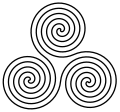



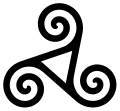
Familiar as an ancient symbol of Sicily, the symbol dates back to when Sicily was part of Magna Graecia, the colonial extension of Greece beyond the Aegean.[8] Pliny the Elder attributes the origin of the triskelion of Sicily to the triangular form of the island, the ancient Trinacria (from the Greek tri- (three) and akra (end, limb)), which consists of three large capes equidistant from each other, pointing in their respective directions, the names of which were Pelorus, Pachynus, and Lilybæum.
The Celtic symbol of three conjoined spirals may have had triple significance similar to the imagery that lies behind the triskelion. The triple spiral motif is a Neolithic symbol in Western Europe. It is considered a Celtic symbol but is in fact a pre-Celtic symbol.[9] It is carved into the rock of a stone lozenge near the main entrance of the prehistoric Newgrange monument in County Meath, Ireland. Newgrange, which was built around 3200 BC,[6] predating the Celtic arrival in Ireland but has long since been incorporated into Celtic culture.

Triple spiral visible on entrance stone at Newgrange.

.





Familiar as an ancient symbol of Sicily, the symbol dates back to when Sicily was part of Magna Graecia, the colonial extension of Greece beyond the Aegean.[8] Pliny the Elder attributes the origin of the triskelion of Sicily to the triangular form of the island, the ancient Trinacria (from the Greek tri- (three) and akra (end, limb)), which consists of three large capes equidistant from each other, pointing in their respective directions, the names of which were Pelorus, Pachynus, and Lilybæum.
The Celtic symbol of three conjoined spirals may have had triple significance similar to the imagery that lies behind the triskelion. The triple spiral motif is a Neolithic symbol in Western Europe. It is considered a Celtic symbol but is in fact a pre-Celtic symbol.[9] It is carved into the rock of a stone lozenge near the main entrance of the prehistoric Newgrange monument in County Meath, Ireland. Newgrange, which was built around 3200 BC,[6] predating the Celtic arrival in Ireland but has long since been incorporated into Celtic culture.

Rhine
Celts, electrum 'regenboogschoteltje' or rainbow cup with
triskele

Triskel modelled after those of the Amfreville Gaulish helmet.
It appears as a heraldic emblem on warriors' shields depicted on Greek pottery.

Triskel modelled after those of the Amfreville Gaulish helmet.
It appears as a heraldic emblem on warriors' shields depicted on Greek pottery.
Neolithic, Bronze Age, and Iron Age use in EuropeThe triskelion symbol appears in many early cultures, the first in Malta (4400–3600 BC) and in the astronomical calendar at the famous megalithic tomb of Newgrange in Ireland built around 3200 BC,[6] Mycenaean vessels, on coinage in Lycia, and on staters of Pamphylia (at Aspendos, 370–333 BC) and Pisidia.

Ancient
Greek beaked jug decorated with triple spirals

Auspicious
carved stone from the hill-fort of Santa Tegra (A Guarda, Galicia)
A modern labeling mark (Blessed by Druids)
According
to Ellen Evert Hopman of the Order of the Whiteoak (Ord
Na Darach Gile),
“this symbol, designed by
J.
Craig Melia,
is meant
to function as a Druidic equivalent to the Kosher marks used in
Judaism
W::
Well:Celtic Irish myth of the Well of Segais (Well of Wisdom), a well or pool surrounded by nine hazel trees.
W::
Well:Celtic Irish myth of the Well of Segais (Well of Wisdom), a well or pool surrounded by nine hazel trees.
The
Numbers:
1::
2::
3::
2::
3::
While
Three was the magic number of binding and establishing, nine
symbolized completeness and wholeness.
Ref
09"The
Cauldron of Poesy" Here we have both internal Cauldrons and
again the number
three.
http://www.ancientmusic.co.uk/files/cauldron_of_poesy.pdf
http://www.ancientmusic.co.uk/files/cauldron_of_poesy.pdf
4::
Now four is interesting and has many possibilities. In the Four Treasures we see four items and four lost cities too. One could see many ways to use these.
Four
magickal treasures from the four great ancient cities of the DTT
xxxxx:
The
Stone of Fal, from Falias;
The Spear of Lugh, from Gorias;
The Sword of Nuada, from Findias;
The Spear of Lugh, from Gorias;
The Sword of Nuada, from Findias;
The
Cauldron of the Dagda, from Murias.
5::
The
Fairy count by five:
While
the old man smiled, and Gwyn renewed his vow, the new wife began
to count by fives--one, two, three, four, five.
( http://www.zeluna.net/welsh-fairytales-theladyofthelake.html)
Mythological figures wore five-fold cloaks:
( http://www.zeluna.net/welsh-fairytales-theladyofthelake.html)
Mythological figures wore five-fold cloaks:
Some also call a Pentacle a Druid's Foot.
See
Penta
Pentacle Pentagram,
for a deeper look at the
Fives.
http://hoodoo-vodou-druidogrove.blogspot.com/2014/05/penta-pentacle-pentagram.html
6::
7::
8::
9::
Nine : while Three was the magic number of binding and establishing, nine symbolized completeness and wholeness.Celtic Irish myth of the Well of Segais (Well of Wisdom), a well or pool surrounded by nine hazel trees.
http://hoodoo-vodou-druidogrove.blogspot.com/2014/05/penta-pentacle-pentagram.html
6::
7::
8::
9::
Nine : while Three was the magic number of binding and establishing, nine symbolized completeness and wholeness.Celtic Irish myth of the Well of Segais (Well of Wisdom), a well or pool surrounded by nine hazel trees.
So do any or all of these symbols fit one Druidry, where, how and why?
Each of us must answer that for our selves or accept what ever Order if any we follows ideas.
Other Links, may be of value or not, you be the judge:
http://www.whats-your-sign.com/five-fold-celtic-meanings.html
http://www.symbolism.co/celtic_symbols.html
Moon Rising
TDK / The Druid King
No comments:
Post a Comment